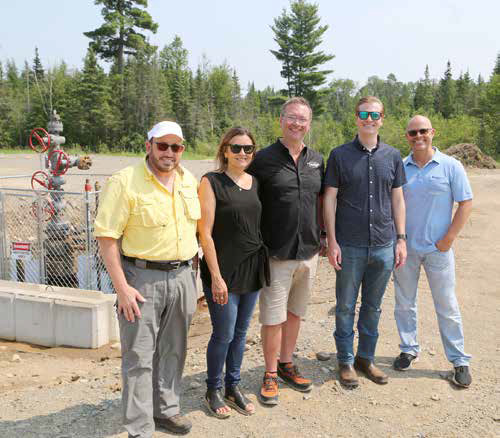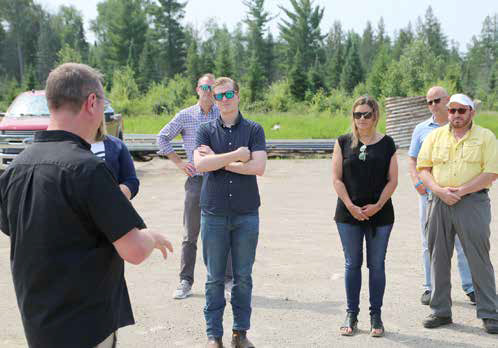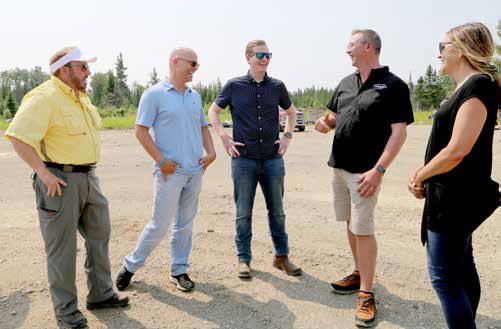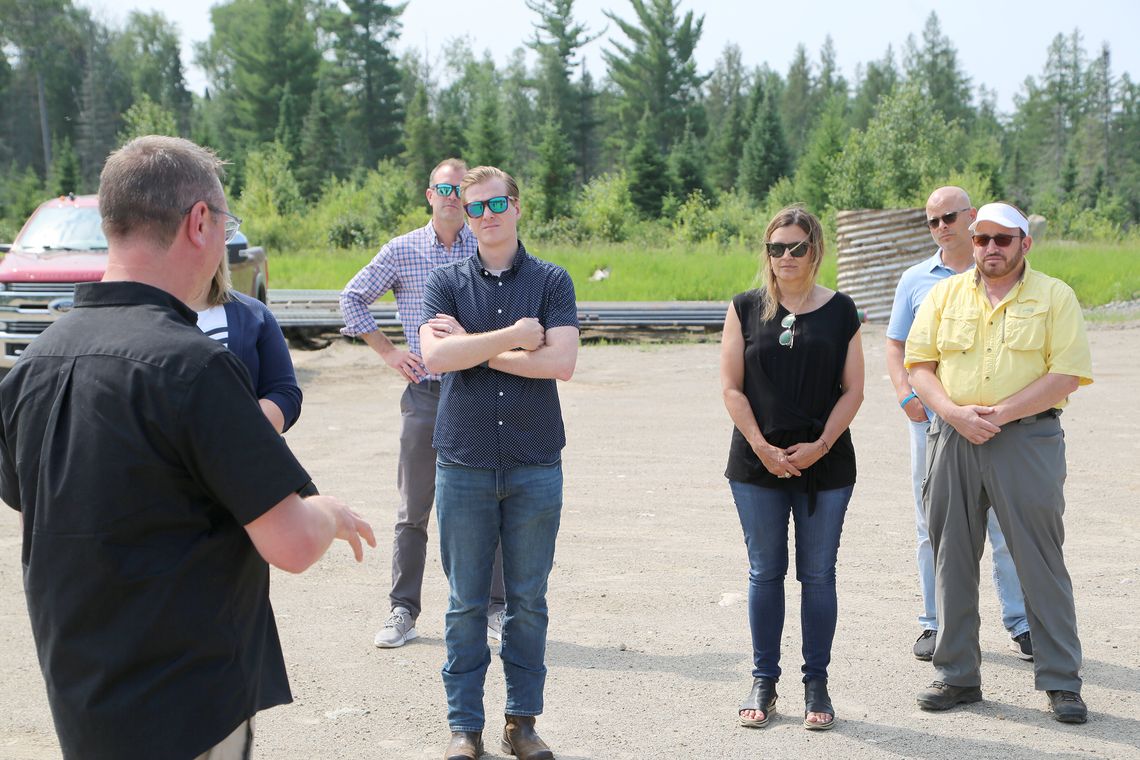Production could start as soon as next year
Four area legislators received a personal update from the President of Pulsar Helium, Thomas Abraham- James, in an Aug. 31 on site tour.
Abraham-James explained the beginning, current status and future outlook for a company that struck gold with one of the highest concentrations of helium ever found anywhere on Earth.
Abraham-James said it’s possible production could start as soon as next year with the company tapping the 14.5 percent of helium that has roared out of a well that has already underground substantial testing.
On Aug. 7, Pulsar will conduct seismic testing to help determine the size of the helium deposit which will go toward answering how long a plant east of Babbitt near Hwy. 2 would be in production.
Legislators Rep. Roger Skraba (R-Ely), Rep. Natalie Zeleznikar (R-Hermantown), Sen. Grant Hauschild (DFL-Hermantown) and Rep. Dave Lislegard (DFL-Aurora) had plenty of questions at the site.
Abraham-James said pulsar has come a long way since they started acquiring private landowner mineral rights in 2017 and having discussions with the state Department of Natural Resources.
“Everyone thought we were crazy talking about non-hydrocarbon gases in northern Minnesota,” said Abraham-James.
While the company’s stock took a large initial jump, it has settled in and even dropped as investor’s wait for answers.
“How big is this thing? That’s the biggest question,” said Abraham-James. “What we’ve been doing before we drilled in February was the build up work. So airborne surveys, geophysics, ground, seismic, all these things to build up a picture saying, is this an isolated occurrence? Are we looking at something that’s regional in this extent? And the data proved that this does appear to be something which is significant so it’s not in the isolated pocket.”
The company was able to replicate the results of the initial test drilling that accidentally found the helium in 2011.
The well drilled in February went to 1,760 feet and Abraham-James said Pulsar now believes the deposit may go even deeper.
“We now know that this is very likely to extend for another 1,000 feet,” said Abraham-James.
Pulsar will extend their exploration much farther than the 50 feet from the original drill hole.

ON SITE for the Pulsar Helium update were Rep. Roger Skraba, Rep. Natalie Zeleznikar, President of Pulsar Helium, Thomas Abraham-James, Sen. Grant Hauschild and Rep. Dave Lislegard. Photo by Steve Groteboer.
“Our intention is later this year, we’re going to drill deeper and then do some step out wells about a mile away from where we are now and see okay, can we replicate this? Is the reservoir connected, this hole and the other one, so they talk to each other? That really decreases the risk around the resource. How believable is it? How long can it produce for? And those are the questions that we hope to have answered by the end of this year,” said Abraham-James.
He credited the four legislators for working together to get legislation passed that will set rules on the process as well as implement production taxes on helium deposits in Minnesota.
“Having clarity around that is really key,” said Abraham- James.
He said Pulsar may be the first company in Minnesota to mine helium but there will be others. He said hydrogen has been found here as well.
“We know that this geological feature that’s here, it does extend into Ontario, and it does go down to Iowa. This is a big, regional deposit,” said Abraham-James. “I think that being the first mover advantage is extremely important for attracting new people here as well. I mean, for us we’re very supportive of new entrants coming in looking for helium. We know this is a big play. And it’s never great being the only kid in town.”
In addition to the company’s private mineral rights on over 2,089 net acres, Pulsar has an exclusive option for 2,092 additional net acres.
Abraham-James said Pulsar is now pursuing state leases as well.
“We want state land as well, because we have data already collected over a very good area. And we could effectively instead of being constrained by imaginary boundaries, but to go out into that state land, it is actually very important for us to have all the rules on royalties, everything, we will adhere to the rules,” said Abraham- James.
He said the company has already gone above and beyond current drilling regulations, which actually caused the state to issues two variances for exceeding state standards.
“Now with the feedback from the public health department that said that’s the right the way you’re doing it, and it actually makes an awful lot of sense that you do it this way. Maybe we’ll be grading our regulations in line with what you’re doing, which is really nice to hear,” said Abraham-James.
Pulsar did find the state is still catching up on the permitting and leasing rules, but they expect that process to play out fairly quickly.
Skraba asked about if there has been progress on rules regarding pooling where helium and other gases could be extracted from other adjacent lands.
Abraham-James said pooling in established oil wells is much different than dealing with helium.
“Mother Nature is a different beast. So it’s actually extremely hard to be able to predict that connectivity until we conduct the work,” said Abraham-James.
Skraba also asked about the origins of the helium and whether it is continuing to be produced underground.
“The most prolific helium plant in the USA is in Wyoming. It’s owned by Exxon Mobil. It’s a helium and CO2 production facility that is almost a copy paste of what we have right here. So the most prolific is a CO2 dominant system,” said Abraham-James.
He explained the helium is created by the ancient Duluth Complex.
“You’ve got some of the oldest rocks on the planet,” said Abraham-James. “The older rocks are very well endowed with uranium and thorium. They’re big elements that are incompatible with old rock types. So the old rocks get rid of like the gunk. So the uranium and thorium, they decay and one thing that is created is what’s called an alpha particle, which is a helium atom that’s produced and so we know that this area is prolific for the production, because the age and the endowment with those radioactive elements. But there’s no radioactivity anymore. That’s billions of years ago.”
Abraham-James said often times the gas is sealed in granite but in the Duluth Complex the Mid-Continent Rift created fractures in the rock that hold the helium until it can reach the surface.
In addition there is CO2 at high concentrations, as much as seven times the level of helium. He said Minnesota has to import its CO2 so there is a market for that as well.
“So you’ve got this sort of Goldilocks zone, which is highly favorable to helium and CO2,” said Abraham James. “But importantly, not hydrocarbons. Hydrocarbons is the kiss of death in our business.”
The company believes they are getting close to being able to bring helium and CO2 to market.
“I think, next year, there’s a distinct possibility that we may be able to see a bit of production starting. We feel with an aggressive schedule that may be possible,” said Abraham-James.
While helium has many uses from medical to semiconductors to fiber optics, Abraham-James said there is also a market for CO2. Helium would be sold in a gas form while CO2 would be in a liquid form.
“CO2 is used in drinks of course, beer for example, food for packaging, and then also for potable water. So for tap water to change the pH level, they include CO2 to drop the acidity and that’s a major use,” said Abraham- James.
He said CO2 is mainly used for pushing oil out of the ground.
“So what that leaves behind is the CO2 needed for food, beverage and potable water,” said Abraham-James. “And Minnesota being so far from the market, it’s amplified.”
Pulsar believes helium could be used in Minnesota’s semiconductor plants.
The company may build a facility in Two Harbors to turn the helium from a gas to a liquid.
“Interestingly the gold standard of helium production facilities is manufactured in New Prague, Minnesota,” said Abraham-James.
Abraham-James did respond to a question about Minnesota having such a diverse group of minerals and now gases located in the northeast part of the state.
“Here you’ve got platinum, palladium, copper, nickel, iron, helium, gold that’s a computer chip right there,” said Abraham-James.
Pulsar’s CEO said the company made a conscious decision to share its information along the way.
Skraba said that helped in St. Paul when environmental groups endorsed the legislation regulating production.
“As a company we had a choice to fly under the radar, be quiet and hope nobody notices or full disclosure. And of course we took the latter option,” said Abraham-James. “And thank goodness, we took that approach and full transparency.”
Zeleznikar credited the company for being an open book to the public.
“You brought everybody to the table right from the start,” said Zeleznikar. “ You eliminate all the issues that happen when people aren’t allowed to ask questions and to see firsthand like we’re doing today. When you do that, I think it builds trust. That builds credibility that will go miles.”
On jobs created, Abraham- James said the process will be fairly automated but he expects 20 jobs but believes there will be ancillary jobs as well.
He said the company will need electricity but no pipelines will be built.
When sked about the value if a truck per day of helium is exported from the site, Abraham-James said one truck would hold a million cubic feet of liquid helium which would be more than $1 million. Skraba asked about the CO2 value but Abraham- James said that dollar amount can vary widely since it is not publicly traded.
Abraham-James explained the different gases are separated using membranes and temperature control.
“What we would do is that the bulk of gas will come out and then probably the likely first step would be go through a series of membranes, and they scrub out the atomic size of the gases until helium remains,” said Abraham-James.

LISTENING to Pulsar Helium president Thomas Abraham-James were Sen. Grant Hauschild, Rep. Natalie Zeleznikar, Rep. Dave Lislegard and Rep. Roger Skraba. Photo by Steve Groteboer.

SHARING A LAUGH with Pulsar Helium president Thomas Abraham-James (second from right) were Rep. Roger Skraba, Rep. Dave Lislegard, Sen. Grant Hauschild, and Rep. Natalie Zeleznikar on a site visit Aug. 31. Photo by Steve Groteboer.











